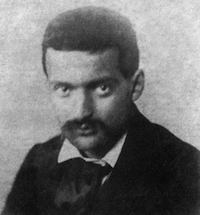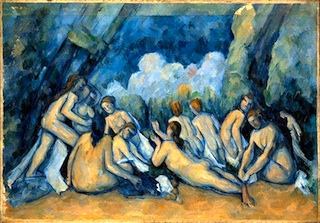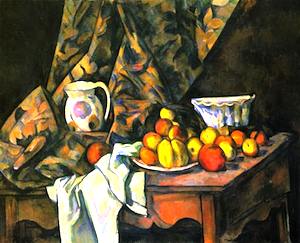Cezanne: Part 2, Bridge Between Centuries

- SUBSCRIBE
- ALREADY SUBSCRIBED?
BECOME A BONJOUR PARIS MEMBER
Gain full access to our collection of over 5,000 articles and bring the City of Light into your life. Just 60 USD per year.
Find out why you should become a member here.
Sign in
Fill in your credentials below.
 This is a continuation of this story: Paul Cezanne: Bridge Between Centuries
This is a continuation of this story: Paul Cezanne: Bridge Between Centuries
It is said that Paul Cézanne’s early paintings reflected the grim, interior world of the man. Shy, socially awkward, perhaps even misanthropic, Cézanne was unhappy in Paris. The Franco-Prussian War (1870-71) provided him the perfect excuse to leave the crowds of the big city. He fled south to escape the draft, taking his companion and future wife, Marie-Hortense Fiquet, with him.
Back in the country, Cézanne was freed by the invention of pre-mixed tube paint to work in the open air. Once outside, his spirit eased and his palette lightened. His touch, now applied with brushes, became finer and more precise. Indeed, the older and more mature he grew as an artist, the longer he contemplated each and every movement. By the end of his life, it could take Cézanne as much as 20 minutes to execute a single brushstroke.
 Fortunately for his live models, Cézanne became more and more interested in the interplay of light and geometry on form rather than on form itself. As the 19th century waned, his preference shifted to rendering groups of female bathers from wooden dolls with articulating limbs; still lives of everyday objects and fruit slow to rot, like apples and oranges; and his favorite vista, Mount Sainte-Victoire.
Fortunately for his live models, Cézanne became more and more interested in the interplay of light and geometry on form rather than on form itself. As the 19th century waned, his preference shifted to rendering groups of female bathers from wooden dolls with articulating limbs; still lives of everyday objects and fruit slow to rot, like apples and oranges; and his favorite vista, Mount Sainte-Victoire.
Little by little, the reclusive Cézanne developed a kind of architectural style of painting, depicting a scene by first breaking it down into its most basic shapes and planes of color, then putting them back together again to build not so much a representation, but a re-creation, of reality.
This was the origin of Cubism. But to Cezanne it was merely an attempt to simplify naturally occurring forms to their most basic geometric essentials so as to give an impression of scene to the viewer, and allow his or her gaze, mind, imagination and emotional world to do the rest. This was Cezanne’s gift to the 20th century and why both Matisse and Picasso revered him as “the father of us all.”
 Cézanne was once remembered for having said that he hoped to die with a brush in his hand. On 22 October 1906, he did. He succumbed to pleurisy after a day in the pouring rain, working two kilometers from his studio on his 87th version of the Mount Sainte-Victoire. He left us 92 bathers and more than 200 still lives as well. The works painted from his atelier, combined with the four decades of paintings that preceded them, meant that Paul Cézanne gave us a very rich legacy, indeed.
Cézanne was once remembered for having said that he hoped to die with a brush in his hand. On 22 October 1906, he did. He succumbed to pleurisy after a day in the pouring rain, working two kilometers from his studio on his 87th version of the Mount Sainte-Victoire. He left us 92 bathers and more than 200 still lives as well. The works painted from his atelier, combined with the four decades of paintings that preceded them, meant that Paul Cézanne gave us a very rich legacy, indeed.
However, upon the great visionary’s death the French government laid no claims to his groundbreaking efforts and his collection, bought mostly by private collectors, scattered to the four corners of the globe. Even today, few pieces by Cézanne can be found in French museums.
And what of his famous atelier? It was saved from destruction in 1954 thanks to the efforts of American art-lovers and historians, John Rewald and James Lord, who, under the auspices of the Cézanne Memorial Committee, raised the funds necessary to purchase the building and grounds.
 You can tour the Atelier Paul Cézanne today: 9, avenue Paul Cézanne, 13090 Aix-en-Provence. And while you’re there, walk up to his mountain viewpoint. You can also now visit the Carrières de Bibémus, Bibemus Quarries, the subject of many of Cézanne’s works from the 1890s, and the former Cézanne family estate, the Manor of Jas de Bouffan.
You can tour the Atelier Paul Cézanne today: 9, avenue Paul Cézanne, 13090 Aix-en-Provence. And while you’re there, walk up to his mountain viewpoint. You can also now visit the Carrières de Bibémus, Bibemus Quarries, the subject of many of Cézanne’s works from the 1890s, and the former Cézanne family estate, the Manor of Jas de Bouffan.
Paul Cézanne: Bridge Between Centuries, Part I, was published in the previous issue of BonjourParis.
Sarah Towle is founder & creative director of Time Traveler Tours, interactive mobile itineraries for teens, ‘tweens and the young at heart that put history in the palm of your hand. The first tour in the Time Traveler Tours Paris series, Beware Madame la Guillotine!, will launch this month. Sarah also maintains a weekly blog about French history and culture.
PHOTO CREDITS
The Bathers, courtesy of London National Gallery
Photo of Cezanne, 1861 (Age 23)
PRACTICAL INFORMATION
Aix-en-Provence Office de tourism site
2, place du Général de Gaulle, F-13100 Aix-en-Provence
Tél (0)4 42 16 11 61
L’atelier des Lauve, Cézanne’s studio
Want to know more about Cézanne & his contemporaries?
 “Cézanne in Provence” is a documentary that explores the life and work of Paul Cézanne (1839-1906), a leading figure in the impressionist and post-impressionist movements who had a profound influence on the course of modern art. Shot on location in Provence and at the National Gallery of Art, Washington, DC, where the Cézanne exhibit opened in January 2006. A critically-acclaimed PBS documentary. This fascinating DVD is just one of several France-related items available at our Amazon.com French Marketplace; more information here.
“Cézanne in Provence” is a documentary that explores the life and work of Paul Cézanne (1839-1906), a leading figure in the impressionist and post-impressionist movements who had a profound influence on the course of modern art. Shot on location in Provence and at the National Gallery of Art, Washington, DC, where the Cézanne exhibit opened in January 2006. A critically-acclaimed PBS documentary. This fascinating DVD is just one of several France-related items available at our Amazon.com French Marketplace; more information here.

Dawn of the Belle Epoque: The Paris of Monet, Zola, Bernhardt, Eiffel, Debussy, Clemenceau, and Their Friends by Mary McAuliffe is a June 2011 release recommended by The Federation of Alliances Françaises. It brings to life Paris of 1871. The book is available at our Amazon.com French Marketplace–click here to read the positive reviews and to order.
More in aix, aix en provence, artists, Atelier Paul Cezanne, Carrieres Bibemus, Cezanne, Cezanne Museum Aix, Cubism, culture, France artists, French artists, French history, history, Impressionism, Impressionist, Impressionist art, Jas Bouffan, Matisse, Paris artists, Paris history, picasso, Provence, Provence museum


